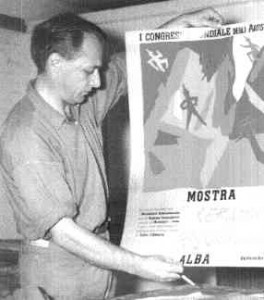On this day in 1956, a group of around twenty obscure radical artists converged on the small Italian town of Alba, just southeast of Turin, for the First World Congress of Liberated Artists. Revolution was the common denominator among these avant-gardists, all of them representatives of Europe’s then most subversive art movements – COBRA, the International Movement for an Imaginist Bauhaus, the London Psychogeographical Association and the Lettrist International. But their vision for revolution was not one driven by justice and suffering, but rather by a lust for the world and a “total critique of [the] idea of happiness” – a World Vision in which art would play a crucial role in creating a new “performance” each and every day, thus bringing people to life. For the next seven days, the delegates discussed the need for a common platform to renew art in order that art could renew life. In a concluding statement, one of its organisers – the Danish painter Asger Jorn – predicted that the First World Congress of Liberated Artists would one day be recognised as “a key moment … in the struggle for a new sensibility and a new culture”.
How right Jorn was. For just ten months later, several of these Alba participants, including representatives from all the aforementioned movements, would reconvene at another Italian conference, which – subsuming many of the already-discussed First World Congress ideas – would declare itself the Situationist International. But let us today remember that momentous meeting up at Alba, for from its utopian Ur-rumblings would the avant-garde movement slowly gather speed and momentum, eventually taking on culture with such finesse and daring that the results would, by May 1968, scare even General De Gaulle into briefly quitting his country – preferring to take refuge in nearby West Germany than risk a head-on confrontation with absurd Situationist forces beyond his ken.



4 Responses to 2nd September 1956 – the First World Congress of Liberated Artists